In late Victorian times, Western Road was mostly residential, yet later became one of Bexhill’s main shopping streets. This was a well-known cinema (The Picture Playhouse), officially opened in 1921 by the Duchess of Norfolk. In 1974, the stalls were turned into a bingo club (later an antiques market) and the circle into the Curzon Picture House. Its final lease of life was in 2005–08 as the Redstack Playhouse theatre/cinema, after which it had remained abandoned.
Photographs and text about Spike Milligan.
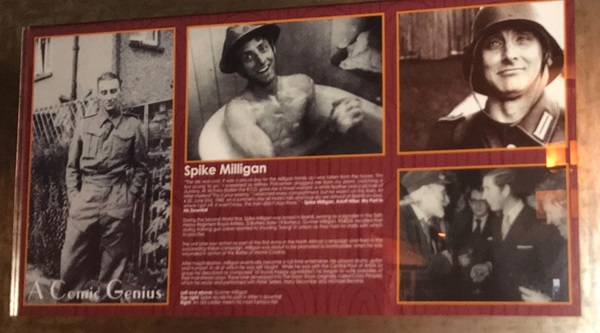
The text reads: “The die was cast. It was a proud day for the Milligan family as I was taken from the house. “I’m too young to go’’ I screamed as military policemen dragged me from my pram, clutching a dummy. At Victoria Station the R.T.O. gave me a travel warrant, a white feather and a picture of Hitler marked ’This is your enemy’. I searched every compartment but he wasn’t on the train. At 4.30pm, June 2 1940, on a summer’s day all mare’s tails and blue sky we arrived at Bexhill-on-Sea, where I got off. It wasn’t easy. The train didn’t stop there’’. – Spike Milligan, Adolf Hitler: My Part in His Downfall
During the Second World War, Spike Milligan was based in Bexhill, serving as a signaller in the 56th Heavy Regiment Royal Artillery, D Battery (later 19 Battery). Gunner Milligan, 954024, recalled that during training gun crews resorted to shouting “bang” in unison as they had no shells with which to practise.
The unit later saw action as part of the First Army in the North African campaign and then in the succeeding Italian campaign. Milligan eventually became a full time entertainer. He played drums, guitar and trumpet, in all of which he was self-taught. While he was with the Central Pool of Artists (a group he described as composed “of bomb-happy squaddies”) he began to write parodies of their mainstream plays. These later developed into The Goon Show (originally called Crazy People) which he wrote and performed with Peter Sellers, Harry Secombe and Michael Bentine.
Left and above: Gunner Milligan
Top right: Spike recalls his part in Hitler’s downfall
Right: An old soldier meets his most famous fan.
Photographs and text about John Logie Baird.

The text reads: The Scottish engineer John Logie Baird demonstrated the first working television system on 26 January 1926. He was also the inventor of both the first publicly demonstrated colour television system, and the first purely electronic colour television system, and the first purely electronic colour television picture tube. In 1928 the Baird Television Development Company achieved the first transatlantic television transmission.
Baird spent the last 18 months of his short and eventful life in Bexhill, where he died on June 14 1946 at the age of 57. He rented a semi-detached house at 1 Station Road, just across the road from the station and handy for the London trains. Baird had a high opinion of the fresh air and the dry climate of East Sussex which had helped him to regain his health in the spring of 1923 after suffering a breakdown. It was whilst he recovered in Hastings that he began his experiments on television.
Baird divided his time between Bexhill and London, until a stroke confined him to bed. He died in his sleep, just a week after the BBC resumed broadcasting after the wartime restrictions. The house in Bexhill was split into flats and named Baird Court. It was demolished in August 2007 and replaced by a new block of flats with the same name.
Above: Baird in Hastings, January 1924, where he gave the first demonstration of an analogue television system
Top left: Baird being televised from the first purpose-built television studio
Top right: John Logie Baird in 1917
Left: Baird demonstrating his colour television system in 1940
Right: Baird in his laboratory, working on a cathode-ray tube, c1944.
Photographs and text about Rosalind Franklin.

The text reads: The future ‘Dark Lady of DNA’ was educated in Bexhill. At the age of nine, Rosalind Franklin was sent to Lindores School for Ladies, because it was near the sea and would help with her supposed ‘delicate health’. She was here for two years, before she joined St Paul’s Girls School in London.
She excelled in science, Latin and sports, and at the time St Paul’s was one of the few schools in London where girls were taught science. She majored in physical chemistry at Newnham College, Cambridge, where her teachers included the spectroscopist WC Price and JD Bernal, an early pioneer in X-ray crystallography and molecular biology.
Franklin’s notable achievement was the X-ray photographs she took of DNA, which Bernal, her former teacher claimed were “amongst the most beautify X-ray photos of any substance ever taken”. Franklin’s photograph, labelled 51, taken of B-DNA in 1952, was the first proof of the double helical structure of DNA. This photograph provided critical data for Crick and Watson’s building of their DNA double helix model.
In 1951 Franklin had indicated that DNA was likely to be a double helix, at a lecture where James Watson was in the audience. Her work in this area however, was cut short, when aged just 38 years old she died of ovarian cancer. Some commentators attribute Franklin’s cancer to the X-ray radiation she had been exposed to during her work.
Above: Lindores School, Bexhill
Right: Rosalind (back row, far right) in her school hockey team
Centre right: James Watson and Francis Crick with their DNA model, 1953.
Photographs and text about the De La Warr Pavilion.
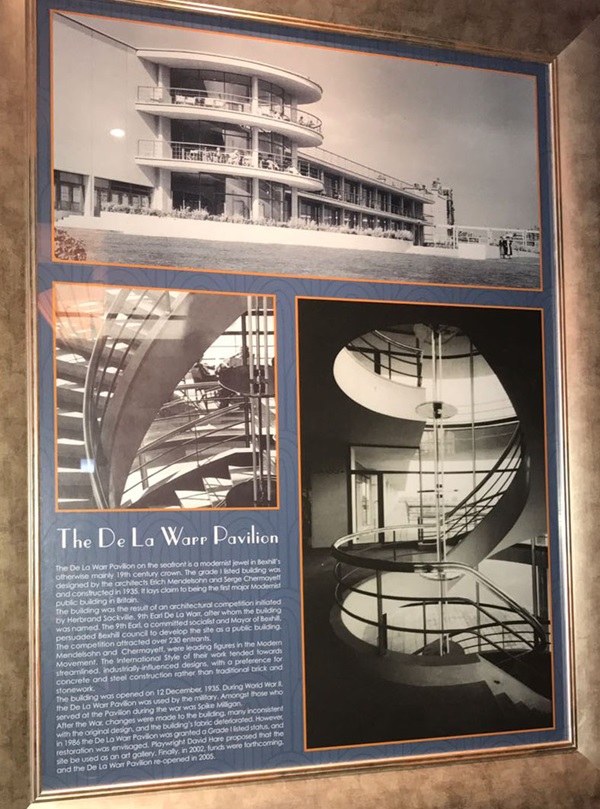
The text reads: The De La Warr Pavilion on the seafront is a modernist jewel in Bexhill’s otherwise mainly 19th century crown. The grade I listed building was designed by the architects Erich Mendelsohn and Serge Chermayeff and constructed in 1935. It lays claim to being the first major modernist public building in Britain.
The building was the result of an architectural competition initiated by Herbrand Sackville, 9th Earl De La Warr, after whom the building was named. The 9th Earl, a committed socialist and mayor of Bexhill, persuaded Bexhill council to develop the site as a public building. The competition attracted over 230 entrants.
Mendelsohn and Chermayeff were leading figures in the Modern Movement. The international style of their work tended towards streamlined, industrially-influenced designs, with a preference for concrete and steel construction rather than traditional brick and stonework.
The building was opened on 12 December, 1935. During World War II, the De La Warr Pavilion during the war was Spike Milligan.
After the war, changes were made to the building, any inconsistent with the original design, and the building’s fabric deteriorated. However, in 1986 the De La Warr Pavilion was granted a grade I listed status, and restoration was envisaged. Playwright David Hare proposed that the site be used as an art gallery. Finally in 2002, funds were forthcoming and the De La Warr Pavilion re-opened in 2005.
Photographs and text about Dorothy Levitt.
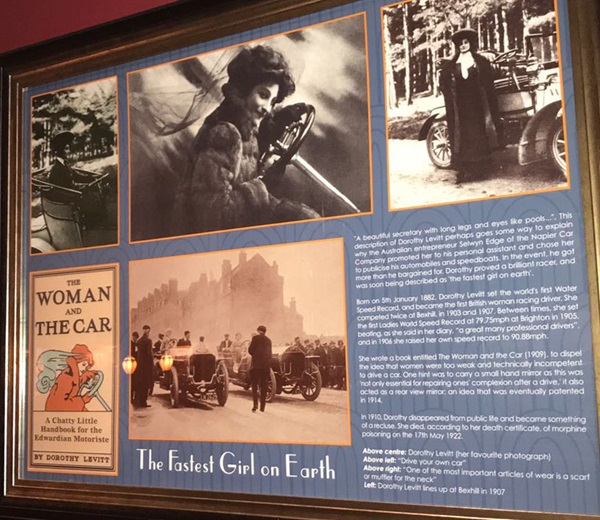
The text reads: “A beautiful secretary with long legs and eyes like pools…”. This description of Dorothy Levitt perhaps goes same way to explain why the Australian entrepreneur Selwyn Edge of the Napier Car Company promoted her to his personal assistant and chose her to publicise his automobiles and speedboats. In the event, he got more than he bargained for. Dorothy proved a brilliant racer and was soon being described as ‘the fastest girl on the earth’.
Born on 5 January 1882, Dorothy Levitt set the world’s first water speed record, and became the first British woman racing driver. She competed twice at Bexhill, in 1903 and 1907. Between times, she set the first ladies world speed record at 79.75mph at Brighton in 1905, beating, as she said in her diary, “a great many professional drivers”, and in 1906 she raised her own speed record to 90.88mph.
She wrote a book entitled The Woman and the Car (1909), to dispel the idea that women were too weak and technically incompetent to drive a car. One hint was to carry a small hand mirror as this was “not only essential for repairing ones’ complexion after a drive”, it also acted as a rear view mirror; an idea that was eventually patented in 1914.
In 1910, Dorothy disappeared from public life and became something of a recluse. She died, according to her death certificate, of morphine poisoning on the 17 May 1922.
Above centre: Dorothy Levitt (her favourite photograph)
Above left: ‘Drive your own car’
Above right: ‘One of the most important articles of wear is a scarf or muffler for the neck’
Left: Dorothy Levitt line sup at Bexhill in 1907.
Photographs and text about the French Sherlock Holmes.
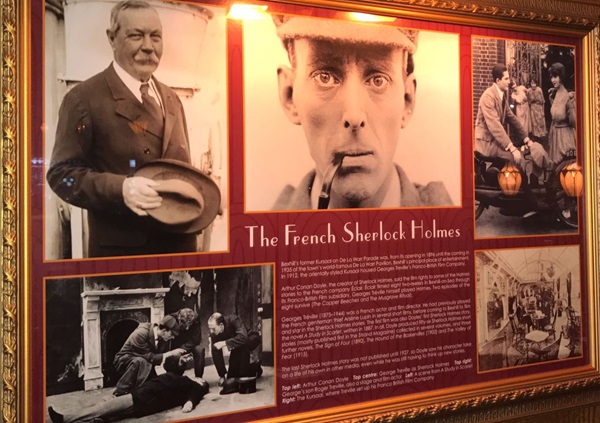
The text reads: Bexhill’s former Kursaal on De La Warr Parade was, from its opening in 1896 until the coming in 1935 of the town’s world-famous De La Warr Pavilion, Bexhill’s principal place of entertainment. In 1912, the orientally-styled Kursaal housed Georges Treville’s Franco-British Film Company.
Arthur Conan Doyle, the creator of Sherlock Holmes, sold the film rights to some of the Holmes stories to the French company Éclair. Éclair filmed eight two-reelers in Bexhill-on-Sea through its Franco-British film subsidiary. Georges Treville himself played Holmes. Two episodes of the eight survived (The Copper Beeches and The Musgrave Ritual).
George Treville (1875-1944) was a French actor and film director. He had previously played the French gentleman thief Arsene Lupin in several short films, before coming to Bexhill to film and star in the Sherlock Holmes stories. The first film was also Doyle’s’ first Sherlock Holmes story, the novel A Study in Scarlet, written in 1887. In all, Doyle produced fifty six Sherlock Holmes short stories (mostly published first in the Strand Magazine) collected in several volumes, and three further novels, The Sign of Four (1890), The Hound of the Baskervilles (1902) and The Valley of Fear (1915).
The last Sherlock Holmes story was not published until 1927, so Doyle saw his character take on a life of his own in other media, even while he was still having to think up new stories.
Top left: Arthur Conan Doyle
Top centre: George Treville as Sherlock Holmes
Top right: George’s son Roger Treville, also a stage and film director
Left: A scene from A Study in Scarlet
Right: The Kursaal, where Treville set up his Franco British Film Company.
Illustrations and text about Henry Lane and John Webb.

The text reads: Henry Lane
Known as the ‘Father of Local Government in Bexhill’, Lieutenant-Colonel Henry Lane (1827-1895) is commemorated by a memorial in Town Hall Square, which records his achievements, both military and political. Most of the money needed to pay for the memorial came from small donations made by local people. Henry Lane was a veteran of the Indian Mutiny. He was the first chairman of the local board and represented Bexhill on the East Sussex County Council.
John Webb
When the 7th Earl De La Warr decided to transform Bexhill into an exclusive seaside resort, he contracted the south London builder, John Webb, to construct the first sea wall and to lay out De La Warr Parade. When the work was completed in 1833 Webb was given, in part payment for his work, all the land extending from Sea Lane to the Polegrove, south of the railway line.
Webb developed his land despite difficult economic conditions. He laid out Western Road, the Egerton Park Estate and most of the business district of the New Town.
Photographs, an illustration and text about the 8th Earl De La Warr.
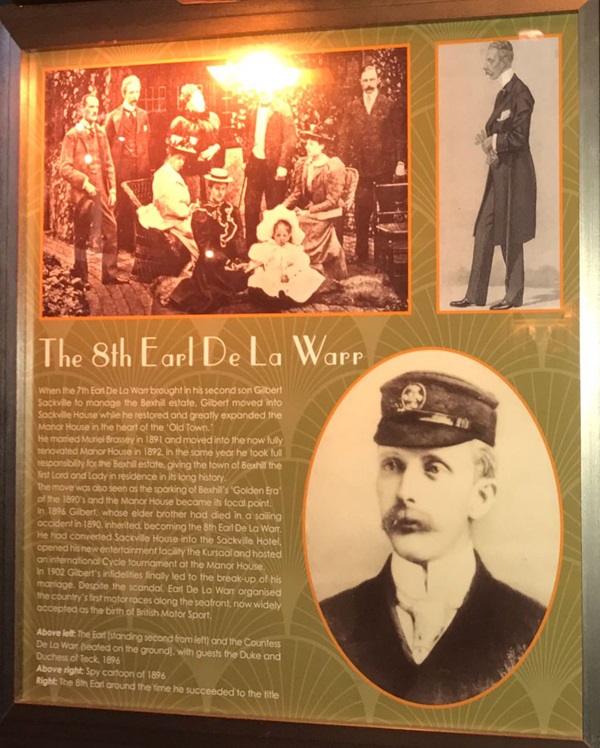
The text reads: When the Earl De La Warr brought in his second son Gilbert Sackville to manage the Bexhill estate, Gilbert moved into Sackville House while he restored and greatly expanded the Manor House in the heart of the Old Town.
He married Muriel Brassey in 1891 and moved into the now fully renovated Manor House in 1892. In the same year he took full responsibility for the Bexhill estate, giving the town of Bexhill the first lord and lady in residence in its long history.
The move was also seen as the sparking of Bexhill’s ‘Golden Era’ of the 1890s and the Manor House became its focal point. In 1896 Gilbert, whose elder brother had died in a sailing accident in 1890, inherited, becoming the 8th Earl De La Warr. He had converted Sackville House into the Sackville Hotel, opened his new entertainment facility the Kursaal and hosted an international cycle tournament at the Manor House. In 1902 Gilbert’s infidelities finally led to the break-up of his marriage. Despite the scandal, Earl De La Warr organised the country’s first motor races along the seafront, now widely accepted as the birth of British Motor Sport.
Above left: The Earl (standing second from left) and the Countess De La Warr (seated on the ground), with guests the Duke and Duchess of Teck, 1896
Above right: Spy cartoon of 1896
Right: The 8th Earl around the time he succeeded to the title.
Prints of Bexhill’s cinema.
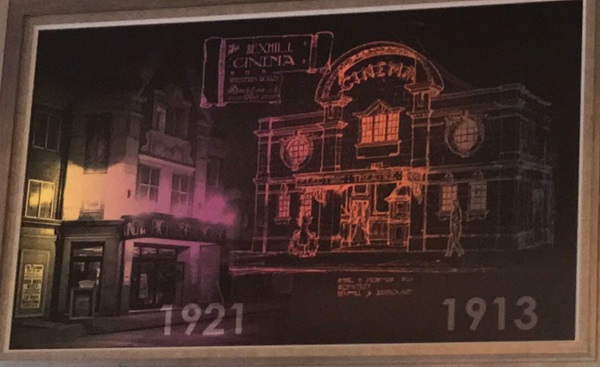
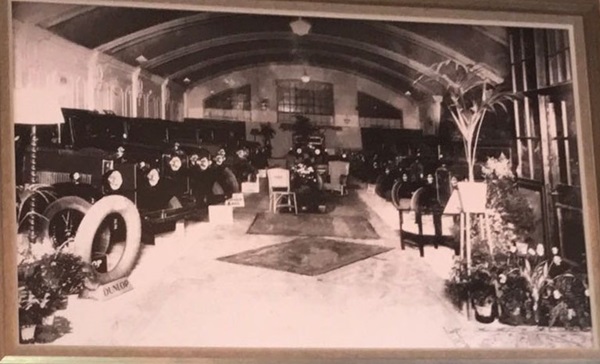
External photograph of the building – main entrance.

If you have information on the history of this pub, then we’d like you to share it with us. Please e-mail all information to: pubhistories@jdwetherspoon.co.uk